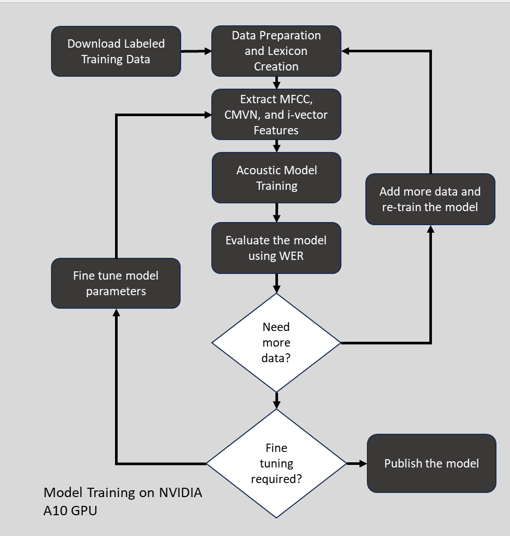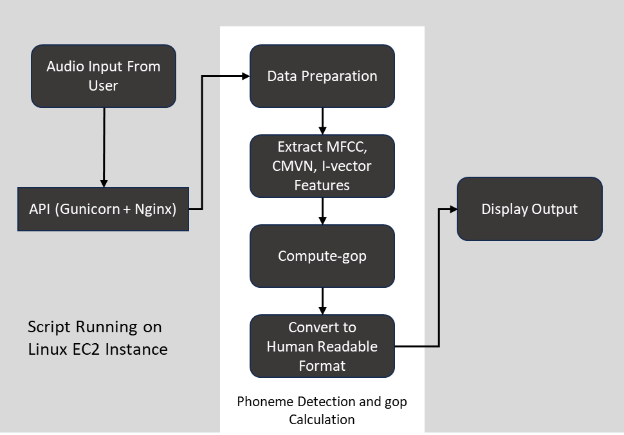A Deep Dive into Phoneme-Level Pronunciation Assessment
In the rapidly evolving digital education domain, our team at Rudder Analytics embarked on a pioneering project. We aimed to enhance language learning through cutting-edge AI and machine learning technologies. Partnering with a premier language learning platform, we sought to address a significant challenge in the field: providing detailed and actionable feedback on pronunciation at the phoneme level, a critical aspect of mastering any language. This case study delves into the sophisticated technical landscape we navigated to develop an advanced phoneme-level pronunciation assessment tool, showcasing our data analytics, engineering, and machine learning expertise.
Navigating the Challenge: Beyond Conventional Solutions
The initial challenge was the limitations of out-of-the-box pronunciation scoring APIs provided by major cloud services like GCP, Azure, and AWS. These services, while robust, fell short of delivering the granular level of detail required for effective pronunciation assessment. To overcome this problem, the decision was made to construct a bespoke model that could meet the specific needs of the platform.
Our objective was clear: to architect a solution that transcends these limitations, enabling a more personalized and impactful learning experience.
Holistic Approach: Integrating Advanced Algorithms with Linguistic Insights
Our strategy was anchored in a holistic approach, merging advanced machine learning techniques with deep linguistic insights to achieve higher accuracy in pronunciation assessment.
If you are interested in the codebase, check out our GitHub repository
Goodness of Pronunciation (GOP)
A cornerstone of our approach was the implementation of the Goodness of Pronunciation (GOP) metric. GOP, a posterior probability variant, is a quantitative measure of pronunciation accuracy at the phoneme level. It’s an important tool for identifying mispronunciations, enabling targeted feedback for language learners. GOP is used to evaluate the system’s performance in recognizing and scoring the pronunciation of a given utterance.
The Strategic Employment of Kaldi ASR Toolkit
Kaldi, an open-source ASR framework, stands at the core of our solution. Renowned for its flexibility and efficiency in handling speech recognition tasks, Kaldi offers a range of recipes for tailoring acoustic models to specific needs. Our choice to utilize Kaldi was driven by its comprehensive feature set and its ability to be customized for phoneme level detection, a critical requirement for our project.
Data Collection and Preparation
The foundation of our solution was a robust data infrastructure, engineered to handle vast datasets. We utilized the Librispeech dataset, a comprehensive collection of English language audio files. It contains over 1000 hours of speech, recorded by 2,484 speakers, and has been designed to be representative of the different accents and dialects of spoken English. These recordings were made using high-quality microphones and a sound-treated recording environment to ensure high-quality audio.
This dataset contains labeled audio data. We also collected the pronunciation lexicon which included words and their corresponding sequences of phonemes, essential for training our model to recognize and evaluate the smallest sound units in speech.
Major Components
In Kaldi, when computing Goodness of Pronunciation (GOP), the acoustic model, pronunciation lexicon, and language model each play distinct roles in evaluating how well a speaker’s utterance matches the expected pronunciation of words in a given language.
There are 3 main parts of the GOP Speechocean recipe from Kaldi.
Acoustic Model: The acoustic model is trained to recognize the various sounds (phonemes) that make up speech. It maps the raw audio features to phonetic units. In the context of GOP, the acoustic model evaluates how closely the sounds in the speaker’s utterance match the expected phonemes of the correct pronunciation. The model’s confidence in phoneme predictions plays a key role in calculating the GOP score.
Pronunciation Lexicon: The pronunciation lexicon provides the expected phonetic transcriptions of words. It is a reference for how words should be pronounced in terms of phonemes. When calculating GOP, the system uses the lexicon to determine the target pronunciation of words or phrases being evaluated. The comparison between this target pronunciation and the spoken pronunciation (as interpreted by the acoustic model) is fundamental to assessing pronunciation quality.
prepare_lang.sh script is used to prepare lexicon and language-specific data files. It includes creating a lexicon.txt file that contains word-to-phone mapping (eg. Hello -> HH EH L OW)
Language Model: While the language model is primarily used to predict the likelihood of word sequences in speech recognition, its role in GOP can be indirect but important. It can help disambiguate phonetically similar words or provide context that makes certain pronunciations more likely than others, thus influencing the assessment of pronunciation quality. The language model can also ensure that the phoneme sequences being evaluated are within plausible linguistic constructs, which can affect the interpretation of pronunciation accuracy.
Training Process
Preparation of Resources
We gathered a phonetically rich and transcribed speech corpus. Then, set up a pronunciation dictionary (lexicon), language models, and necessary configuration files.
Feature Extraction
Extracted acoustic features from the speech corpus. Commonly used features include MFCCs (Mel-Frequency Cepstral Coefficients) or FBANK (Filterbank Energies).
Training Acoustic Models
We then used the extracted features and transcriptions to train acoustic models. The models learn the relationship between the acoustic features and the phonetic units or words.
Training starts with building a simple model:
Monophone Models: These models recognize phonemes without considering context (neighboring phonemes). They are simpler and less accurate but provide a good starting point. Kaldi’s train_mono.sh script is used to perform the monophone training.
Triphone Models: These models consider the context of phonemes (typically the immediate previous and next phonemes). They are more complex and capture more details about speech patterns. Kaldi’s train_deltas.sh script is used to perform the triphone training.
Refinement: Once triphone models are trained, Kaldi’s train_SAT.sh script is used to refine the model to handle different speakers. SAT stands for Speaker Adaptive Training.
Alignment
Performed forced alignment using the trained acoustic models to align the phonetic transcription with the acoustic features. This step is crucial for GOP as it determines how well the predicted phonemes match the phonemes spoken in the audio.
Kaldi provides align_si.sh script just for this purpose!
The script uses the transcriptions and a lexicon (which maps words to their phonetic representations) to compile training graphs. These graphs represent how words (and their phonetic components) can transition during speech according to the language model.
The script performs the alignment task using the training graphs, the existing acoustic model, and the normalized features. This involves determining the most likely sequence of states (which correspond to phonemes or groups of phonemes) that the acoustic model believes were spoken in each training utterance.
GOP Calculation
The Goodness of Pronunciation score is calculated based on the likelihoods produced by the acoustic model during alignment. GOP is a log-likelihood ratio for each phoneme, normalized by the phoneme duration. It indicates how well the phoneme matches the expected model of that phoneme.
GOP is calculated using the compute-gop script of Kaldi. The steps include:
Compute Posteriors: It first computes the posterior probabilities of different phoneme sequences given the acoustic model and the observed features.
Calculate Log-Likelihoods: The script computes the log-likelihoods for each phoneme occurring at each time frame.
Evaluate Pronunciation: GOP is calculated by comparing the log-likelihood of the most likely phoneme sequence (as per the hypothesis) to alternative phoneme sequences. To avoid bias toward longer phonemes, the score is normalized by the duration of the phoneme.
Pronunciation Profiling
The GOP scores can be used to profile the speaker’s pronunciation. Low scores indicate areas where the speaker’s pronunciation deviates from the expected model.
Model Refinement
Based on the GOP scores, we identified the need for additional training data in areas where the pronunciation model is weak. Additional training and refinement of models may occur iteratively.
Application of GOP
Once the system is well-calibrated, GOP scores can be applied in various ways, such as in language learning applications to provide feedback on pronunciation, in speech recognition systems to improve robustness, or in speaker assessment and training tools.
If you are interested in the codebase, check out our GitHub repository
Model Evaluation
A critical phase of our implementation process was rigorous system testing and evaluation. We assessed the model’s performance using Word Error Rate (WER), a common metric in speech recognition that helped us understand how often the model incorrectly predicted phonemes. WER is a critical metric in the evaluation of Automatic Speech Recognition (ASR) systems, serving as a quantifiable measure of transcription accuracy. It is calculated by comparing the ASR system’s output against a reference transcription, taking into account the number of substitutions, deletions, and insertions needed to match the system’s output to the reference.
Measurable Impact: Enhancing User Experience and Engagement
The deployment of this phoneme-level pronunciation assessment tool has had a profound impact on the platform’s user engagement metrics. We observed a 12% increase in user engagement, a testament to the enriched learning experience provided by our solution. Furthermore, the platform saw an 8% rise in user retention, indicating that users found the tool engaging and effective in improving their skills. Perhaps most telling was the 10% increase in user referrals and testimonials, a clear indicator of the tool’s impact on users’ language learning journeys and its contribution to positive word-of-mouth for the platform.
Conclusion
Our comprehensive approach to enhancing phoneme detection in language learning platforms has set a new standard in pronunciation training. We have crafted a system that improves pronunciation accuracy and enriches the language learning experience by utilizing advanced technological solutions like the Kaldi ASR toolkit. This project exemplifies our commitment to harnessing advanced technology in addressing educational challenges, contributing significantly to the advancement of language learning methodologies.
Elevate your projects with our expertise in cutting-edge technology and innovation. Whether it’s advancing language learning tools or pioneering in new tech frontiers, our team is ready to collaborate and drive success. Join us in shaping the future—explore our services, and let’s create something remarkable together. Connect with us today and take the first step towards transforming your ideas into reality.

